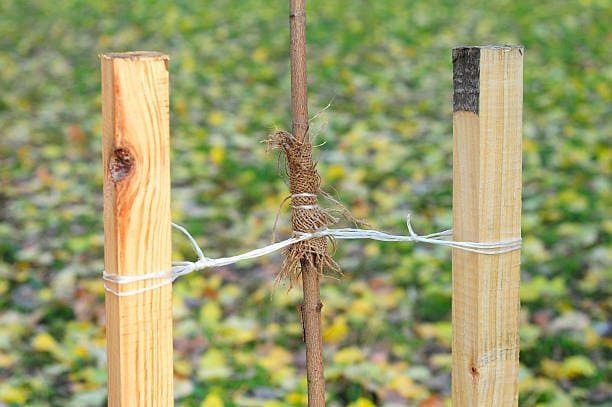When planting a new tree, it is important to properly stake the tree in order to ensure its stability. There are a few different methods that can be used, but the most important thing is to make sure that the tree is securely staked and that the stakes are not damaging the roots. The first step is to choose the right location for the tree. It should be far enough away from buildings and other structures so that it will not be damaged if it falls. The next step is to dig a hole that is twice as wide as the tree’s root ball. Once the hole is dug, mix some organic matter into the soil so that the roots will have something to hold onto. After the tree is planted, use a level to make sure that it is straight before staking it. Finally, drive the stakes into the ground and secure them with guy wires or cables. By following these steps, you can ensure that your new tree will have a long and healthy life.
Table of Contents
How To Stake A Tree
Tree staking plays an integral role in ensuring your tree can become established. It prevents the tree from rocking in the wind and impeding the fibrous root system’s proper development. A newly planted tree may take up to two seasons to become well-established.
If you plant a tree where it can be exposed to strong winds and other elements, it’s advisable to stake it. Read on to learn everything about how to stake trees properly (and how to keep them staked).
When’s the Best Time to Stake a Tree?
It’s best to stake a tree as soon as you plant it, and replace the stakes when they fail. Be sure to check the stakes regularly to prevent overly tight tree ties from damaging the trunk or branches. Also, replace any broken or frayed ties as soon as you notice them.
Remove the stakes once the tree can stand upright without support, which takes at least eighteen months, depending on the tree type.
However, before you stake a tree, determine if it needs additional support. Properly planted trees usually don’t need staking.
Which Trees Need Staking?
Adequately planted trees usually don’t need staking. Nonetheless, staking is often necessary for the following situations:
- Trees with heavy leaf cover and tiny root balls
- Young trees planted in a windy area
- Top-heavy, bare-root trees
- Wet or sandy soil that doesn’t hold the root ball compactly
- Trees with fragile trunks that can’t stay upright without support
- Trees that are predisposed to human or animal disturbance
Challenges of Tree Staking
Staking trees can cause several detrimental issues, mostly if you leave the support in place beyond the first growing season. Improper staking may also damage the new tree, resulting in stunted growth or death.
Here are other common problems that result from improper staking:
- Strong winds cause the trunk to snap at the point where it’s tied to the stake
- Slow root growth, causing the tree to take longer to establish
- Underdevelopment of the trunk, leading to a smaller and more fragile tree
- Tree strangulation from overly taut straps as the tree grows
Tree Staking Methods
There are several ways of staking trees, depending on the tree type, size, and planting method. Nonetheless, make sure the stakes penetrate the soil at least two feet or 60 centimeters deep. The stakes shouldn’t move in the ground, which ensures they offer firm anchorage to the plant.
Let’s explore the different staking methods you should consider depending on your specific needs.
Single Staking
Single staking is the standard way of staking bare-root trees. You’ll need to plant your tree before inserting the stake. Generally, the stake should be one-third of the tree’s height.
The stake supports the roots, allowing the stem to sway and thicken. If your tree is long or has a weak stem, it’s best to use a long, upright stake. Make sure you shorten the stake in the second year, leaving a gap of 2½ – 3 centimeters between the stake and the stem.
Remember to insert the stake on the prevailing wind’s side, so the wind blows the tree away from the stake.
Double Staking
A double stake is ideal for root-balled and container-grown trees, and it is useful in windy areas. This staking method involves inserting two or three stakes opposite each other. Alternatively, you can space the stakes equally around the tree outside the root ball and secure them to the trunk with long ties.
Angled Stake
If you want to stake trees on a slope, an angled stake will work best. This method involves inserting a stake at a 45-degree angle, inclined in the prevailing wind direction, and securing it with a flexible tie. You can install the stake before or after planting your tree.
Guying
If you’re transplanting a large tree, guying is the ideal staking method. This method involves inserting low stakes at a 45-degree angle away from the tree and securing them with a strong wire. Cover any wire wrapped around the tree stem or branches with a rubber hosepipe to prevent rubbing.

How To Stake a Tree Properly
To stake a tree correctly, you’ll need the following items:
- 2×2-inch wooden stakes about five feet tall (consider using metal stakes if you have larger trees or you’re in a windy area)
- A sledgehammer or anything that can drive the stakes into the ground
- A wide, smooth strap for tying around the tree trunk or branches
Once you have everything you need, follow the steps below to stake your tree correctly.
Determine How Many Stakes You Need
The number of stakes to use depends mainly on the tree’s size and location. For a small tree in an area that is not windy, you can use one stake. Larger trees usually need three stakes placed in a triangle shape. Insert the stakes at least 18 inches into the ground and about 1½ feet away from the trunk.
Determine Where to Tie the Stakes
Rock the tree gently back and forth with one hand. Move your hand up or down to find the height at which the tree remains upright when rocked. This height is usually between ½ and ⅔ of the way up the stem.
Tying your tree at less than half its height may lead to the canopy swaying around in the wind, eventually uprooting the entire tree. Likewise, the tree may end up snapping off in strong winds if you tie it right below the lowest branches.
Use a Wide, Flexible Tie
Whether you’re using rubber tubing, pantyhose, or a cloth strap to tie the stakes to the tree, the material should be broad, flexible, and loosely tied. Rigid materials like wire or nylon cord may eat into the bark, undermining your tree’s health.
Leave Room for Slight Movement
Avoid tying the wrap too tightly so the tree can move slightly. You don’t want the tree to move so much that it rubs the bark off. Too little movement may also cause slow growth and development.
While the slight movement promotes stronger roots, it prevents the tree from snapping off in strong winds.
Check Your Tree Regularly
Monitor your staked tree regularly for signs of girdling, abrasion, rocking, or any other problems.
Removing the Stakes
The best time to remove the stakes is at the end of the first growing season. If you stake the tree in the spring, pull the stakes in the fall. Stakes placed in the fall should be removed the following spring.
When removing the stakes, don’t forget to remove the straps around the trunk or branches. Otherwise, the tree may end up growing around the straps, which could impede the efficient flow of water and nutrients, undermining healthy growth and development.
Removing the stakes allows the tree to stand and develop on its own. When done correctly, staking minimizes damage and helps the tree establish itself.
Call the Professionals
If you’re unsure how to stake a tree correctly, it’s best to seek professional help. That’s where Tree Menders come in. We take great pride in our extensive experience, quality work, and exceptional customer service when it comes to tree care.

